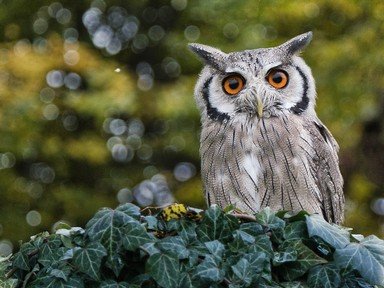Quiz Answer Key and Fun Facts
1. Strix aluco is native to the woodlands of Europe and Asia and has a call that is easily imitated and often (incorrectly) described as "twit twoo, twit twoo". By what name is this owl commonly known?
2. This haughty bird is named after both the area it inhabits and the sound of a loud, piercing cry. Can you name it if I tell you that it can be found along the Pacific coast of Canada, the United States and Mexico?
3. Although this owl is native to eastern areas of the United States it can increasingly be found in western states where it is impinging on the territory of the northern spotted owl. It's also unwelcome in most pubs or taverns. What is its common name?
4. Scops owls tend to be small and highly agile creatures. Despite its rather sleepy appearance, the bird shown in the picture clue is indeed a scops owl. In particular it is a member of the Otus senegalensis species, which is otherwise known by what name?
5. The stature of this owl may give someone the false impression that it is cute and cuddly. In fact it is a highly successful predator, capable of snatching other birds in mid-flight, despite being the smallest owl native to Europe. What is its common name?
6. This strikingly beautiful bird can be found in northern and Arctic areas of North America, Europe and Asia. Females and young birds have dark markings (as shown in the picture clue) but the male is often almost pure white. Can you name this species of owl?
7. This large bird, Bubo virginianus, is one of the most commonly found owls in North America. It is an aggressive species, capable of killing relatively large prey, and is the only regular predator of skunks. By what common name is it best known?
8. This majestic owl, Bubo bengalensis, is native to Asia and tends to live in hilly areas with rocky scrub-land or light forestation. Given that it shares its name with another well-known type of bird of prey, can you name it?
9. To have a chance of spotting this owl you will need to take a trip to sub-Saharan Africa and lurk about in a riverside (or lakeside) forest at night. What bird are you looking for?
10. The final species of owl to be identified is particularly distinctive and is native to large parts of the northern hemisphere, although it has a tendency to migrate southwards for the winter. Unusually it spends the winter in relatively large groups at communal roosting sites. What is it called?
Source: Author
Fifiona81
This quiz was reviewed by FunTrivia editor
Tizzabelle before going online.
Any errors found in FunTrivia content are routinely corrected through our feedback system.

